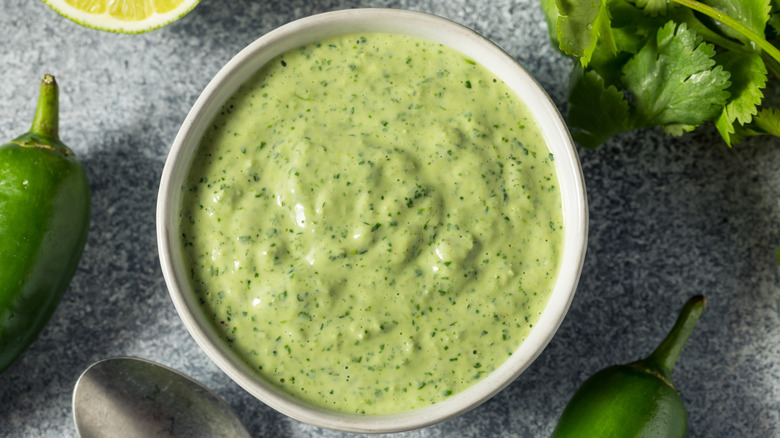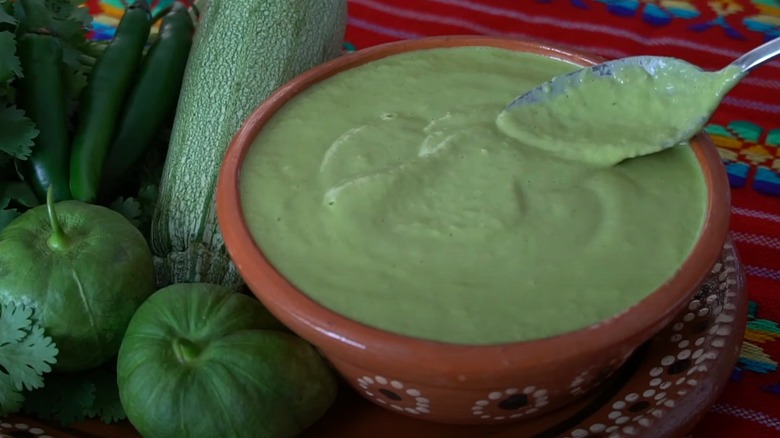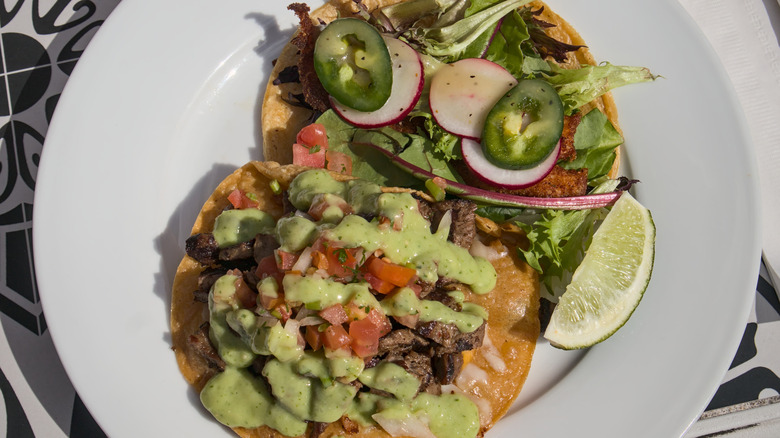The Avocado-Less Guacamole Substitute You've Been Missing Out On
In times of necessity, people get crafty. As avocados became more expensive in the 2010s, Mexican taco sellers had to come up with a more affordable, avocado-free, creamy green topping, or at least that is how the story goes. No one really knows the exact place of origin or inventor of that sauce, but it is definitely here to stay. It is often called guacachile — though it also goes by names like falso (fake) guacamole, salsa taquera (taco vendor's salsa), and salsa verde cremosa (creamy green sauce). If you are a fan of Mexican food, you have more than likely sampled it since it is such a popular sauce.
The creamy texture and pale green color really make it look like a salsa verde with avocado blended in — but instead, it is made by pureeing sauteed onions and green chiles, such as jalapeños and serranos, with oil. The result is shockingly similar to an avocado sauce. While guacachile will not have the exact same texture as a basic guacamole, it definitely brings an adjacent creaminess, acidity, and bright vegetal quality. Plus, if you live in a place where good avocados are hard to come by or prohibitively expensive, this is a great substitute.
How to make guacachile
As with any recipe, there are a ton of variations, and these days, many popular versions include additional ingredients. However, one part of the recipe is consistent — the chiles and onions are cooked in oil, which actually differs from a lot of salsa preparations. For example, salsa tatemada, which is a pretty classic, chunky, roasted red salsa, is made by first charring the ingredients on the stovetop or in the oven — while a typical tomatillo-based salsa verde is made by broiling everything before blending.
For guacachile, the oil is key because creating an emulsion is what gives the sauce body. This is when two liquids that do not easily mix are brought together, which, in this case, are the cooking oil and the water from the vegetables. With just the addition of salt and a blitz in the blender, you get a beautifully cohesive sauce. Sometimes this simple version is called chile verde en aceite (green chiles in oil).
Other versions add in tomatillos, cilantro, garlic, and another ingredient that strengthens the avocado disguise — calabacitas. These are the pale green, zucchini-like summer squash that are sometimes sold as Mexican squash. When simmered and blended into the mix, they add significant body, creaminess, and texture, which is ideal if you want a thicker, scoopable sauce. Regular old zucchini is a perfect stand-in.
What to serve with guacachile
Besides the affordability and ease of making it, this salsa is such a mainstay because it is so versatile. Any grilled meat or vegetable is instantly upgraded with the addition of guacachile. You can also double up on the toppings because it pairs so nicely with something fresh and crunchy, like pico de gallo or pickled red onions. Spoon it onto smoke-kissed carne asada tacos, spread it on a gooey chorizo and cheese torta, or use it to dunk crispy rotisserie chicken flautas.
Guacachile also makes a great addition to an array of chips, salsas, and dips that you might set out at a potluck or game night. For a piquant hit, upgrade a jar of store-bought queso with a dollop, or stir guacachile into Greek yogurt or sour cream for a spicy and tangy dip. Use guacachile to jazz up meal-prepped chicken breasts, loaded baked potatoes, sweet corn on the cob, savory omelets, or pan-seared pork chops. The possibilities really are endless! Avocado who?



